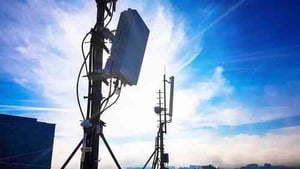What are Small Cell Attachments? Introduction for Joint Use Owners
 Nationwide, utilities and other asset owners are seeing an influx of inquiries and permitting applications for small cell. Today, there are nearly 2.8 million small cell units deployed globally. By 2025, that number is predicted to reach 70.2 million - fueled by the drive to 5G.
Nationwide, utilities and other asset owners are seeing an influx of inquiries and permitting applications for small cell. Today, there are nearly 2.8 million small cell units deployed globally. By 2025, that number is predicted to reach 70.2 million - fueled by the drive to 5G.
The increasing quantity of small cell attachment requests will likely create backlogs, delays, staffing challenges, and stress for asset owners. Managing and coordinating the dramatic increase in attachment permits and make-ready will soon be a significant focus throughout joint use.
What is a Small Cell?
What is Driving the Recent Rush of Small Cell Deployments?
As many as 30 percent of American consumers suffer a coverage problem at home or at work. Small cells enable providers to extend their service coverage and increase network capacity. To prevent signals from being dropped, carriers can blanket the landscape with small cells to form a dense network. Small cells can improve network capacity up to 1,600 times, and improve network performance by 315 percent. Small cells are also being used to in place of Distributed Antenna Systems (DAS.)
Why are Small Cell Deployments Exploding Now?
What Do Small Cells Mean for Joint Use Professionals?
- Allow access by wireless carriers
- Not limit small cell attachments to the “communications space”
- Give access to pole tops when available
- Perform work in a “timely manner”
Small cells may be somewhat new to utility pole owners, but eventually more than 75 percent of small cells will be placed on utility poles. A few basic details can help asset owners better prepare to respond to provider inquiries and permitting applications.
- Size: The size of small cell attachments varies; some may be as small as a TV remote control, but many are the size of a pizza box or briefcase.
- Where to Attach: Most small cells are expected to be placed on utility poles. Others will be deployed on street signs, streetlights, or buildings.
- Distribution: With a range that runs from 10 meters to a few kilometers, small cells can be placed relatively close together. They can reuse the same frequencies many times within a geographical area.
- Ownership: Small cells are typically dedicated to a single carrier. When a pole has been “claimed,” that provider is usually the only one that can attach due to space. Sometimes more than one small cell is allowed.
- Placement: Small cells use low-height antennas, and often have limited coverage. Antenna siting should account for signal interference, including foliage and buildings.
- Community Concerns: Like other types of utility pole attachments, communities are sensitive to the aesthetic impact of small cells. Despite their minimal size, the proliferation of small cell attachments could eventually create visual clutter.
- Support Infrastructure: To transport voice and data from the base station back to its core, carriers may use dark fiber (unused fiber already in the ground), lit circuits (fiber in use), CATV, or a wireless solution. This transport process is called the “backhaul.”
- Zoning and Design: The ideal RF design and pole design is often not the ideal zoning design. Communications between the service provider, asset owner, and the local government from early on can smooth the process.
With the right information, tools and procedures, it is possible for asset owners to manage the growth of small cell attachments. Learn more about small cells and what they mean for the industries involved in joint use – now and in the coming years - in our small cell blog series.
Get help managing the influx of small cell attachment requests; communications with carriers, contractors, and relevant parties; deadlines; make ready work; and other joint use activities with Alden One® – a centralized asset management platform for joint use.
